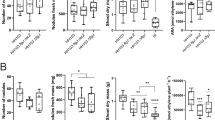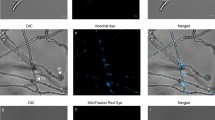Abstract
Colletotrichum trifolii is a fungal pathogen which is responsible for anthracnose disease of alfalfa. To initiate research on molecular communication in this fungus, a kinase-encoding gene (TB3) and the corresponding cDNA were cloned and sequenced. The deduced amino acid sequence ofTB3 closely resembles that of aNeurospora crassa serine/threonine protein kinase, COT1, required for hyphal elongation and branching. The C-terminal catalytic domains of TB3 and COT1 are highly conserved but the N-terminal regions are divergent, particularly in the homopolymeric glutamine repeats of TB3. Northern analysis indicated thatTB3 expression was highest 1 h after inducing conidial germination and 1 h before germ tubes were first observed. Expression of TB3 transcripts returned to constitutive levels by 4 h after induction of germination.TB3 complemented thecot-1 mutant ofNeurospora crassa, demonstrating the functional conservation of this kinase between a pathogenic and a saprophytic fungus.
Similar content being viewed by others
References
Ballance DJ (1986) Sequences important for gene expression in filamentous fungi. Yeast 2:229–236
Barnes DK, Ostazeske SA, Shillinger JA, Hanson CH (1969) Effect of anthracnose (Colletotrichum trifolii) infection on yield, stand, and vigor of alfalfa. Crop Science 9:344–346
Benton W, Davis R (1977) Screening of lambda gt11 recombinant clones by hybridization to single plaques in situ. Science 196:180–182
Buhr TL, Dickman MB (1994) Cloning, characterization and expression of a secondβ-tubulin-encoding gene fromColletotrichum gloeosporioides f. sp.aeschynomene. Appl Environ Microbiol 60:4155–4159
Cathala G, Savouret J-F, Mendez B, West BL, Karin M, Martial JA, Baxter JD (1983) A method for isolation of intact, translationally active ribonucleic acid. DNA 2:329–333
Davis RH, de Serres FJ (1970) Genetic and microbiological research techniques forNeurospora crassa. Methods Enzymol 17A:79–143
Devereux J, Haeberli P, Smithies O (1984) A comprehensive set of sequence analysis programs for the VAX. Nucleic Acids Res 12:387–395
Dickman MB, Buhr TL, Truesdell GM, Warwar V, Huang C (1995) Molecular signals during the early stages of alfalfa anthracnose. Can J Bot 73 (Suppl 1): 1169–1177
Edelman AM, Blumenthal DK, Krebs EG (1987) Protein serine/threonine kinases. Annu Rev Biochem 56:567–613
Emili A, Greenblatt J, Ingles CJ (1994) Species-specific interaction of the glutamine-rich activation domains of Sp1 with the TATA-box binding protein. Mol Cell Biol 14:1582–1593
Emmet RW, Parberry DG (1975) Appressoria. Annu Rev Phytopath 13:147–167
Feinberg AP, Vogelstein B (1983) A technique for radiolabeling DNA restriction endonuclease fragments to high specific activity. Anal Biochem 132:6
Free SJ, Rice PW, Metzenberg RL (1979) Genes coding for rRNAs inNeurospora crassa. J Bacteriol 137:1219–1226
Frischauf A-M, Lehrach H, Poustka A, Murray N (1983) Lambda replacement vectors carrying polylinker sequences. J Mol Biol 170:827–842
Gerber H-P, Seipel K, Georgiev O, Hofferer M, Hug M, Rusconi S, Schaffner W (1994) Transcriptional activation modulated by homopolymeric glutamine and proline stretches. Science 263:808–811
Hanks SK (1987) Homology probing: identification of cDNA clones encoding members of the protein-serine kinase family. Proc Natl Acad Sci USA 84:388–392
Hanks SK, Quinn AM (1991) Protein kinase catalytic domain sequence database: identification of conserved features of primary structure and classification of family members. Methods Enzymol 200:38–62
Hanks SK, Quinn AM, Hunter T (1988) The protein kinase family: conserved features and deduced phylogeny of the catalytic domains. Science 241:42–52
Haribabu B, Dottin RP (1991) Identification of a protein kinase multigene family ofDictyostelium discoideum: molecular cloning and expression of a cDNA encoding a developmentally regulated protein kinase. Proc Natl Acad Sci USA 88:1115–1119
Hunter T (1987) A thousand and one protein kinases. Cell 50:823–829
King K, Dohlman HG, Thorner J, Caron MG, Lefkowitz RJ (1990) Control of yeast mating signal transduction by a mammalianβ 2- adrenergic receptor and Gsα subunit. Science 250:121–123
Muhich ML, Boothroyd JC (1988) Polycistronic transcripts in trypanosomes and their accumulation during heat shock: evidence for a precursor role in mRNA synthesis. Mol Cell Biol 8:3837–3846
Neiman AM (1993) Conservation and reiteration of a kinase cascade. Trends Genet 9:390–394
Nelson M, Van Etten JL, Grabherr R (1992) DNA sequencing of four bases using three lanes. Nucleic Acids Res 20:1345–1348
Orbach MJ, Porro EB, Yanofsky C (1986) Cloning and characterization of the gene forβ-tubulin from a benomyl-resistant mutant ofNeurospora crassa and its use as a dominant selectable marker. Mol Cell Biol 6:2452–2461
Panaccione DG, McKiernan M, Hanau RM (1988)Colletotrichum graminicola transformed with homologous and heterologous benomyl-resistant genes retains expected pathogenicity to corn. Mol Plant-Microbe Interact 1:113–120
Powell WA, Kistler HC (1990) In vivo rearrangement of foreign DNA byFusarium oxysporum produces linear self-replicating plasmids. J Bacteriol 172:3163–3171
Sambrook J, Fritsch EF, Maniatis T (1989) Molecular cloning: a laboratory manual (2nd edn). Cold Spring Harbor Laboratory Press, Cold Spring Harbor, New York
Sanger F, Nicklen S, Coulson AR (1977) DNA sequencing with chain termination inhibitors. Proc Natl Acad Sci USA 74:5463–5467
Staples RC, Hoch HC (1987) Infection structures: form and function. Exp Mycol 11:163–169
Tuite J (1969) Plant pathological methods. Burgess Publishing Co., Minneapolis, p. 30
Vogel HJ (1956) A convenient growth medium for Neurospora crassa (medium N). Micro Genet Bull 13:42–43
Yarden O, Plamann M, Ebbole DJ, Yanofsky C (1992)cot-1, a gene required for hyphal elongation inNeurospora crassa, encodes a protein kinase. EMBO J 11:2159–2166
Author information
Authors and Affiliations
Additional information
Communicated by E. Cerdá-Olmedo
This manuscript has been assigned Journal Series No. 10931, Agricultural Research Division, University of Nebraska
Rights and permissions
About this article
Cite this article
Buhr, T.L., Truesdell, G.M., Huang, C. et al. A kinase-encoding gene fromColletotrichum trifolii complements a colonial growth mutant ofNeurospora crassa . Molec. Gen. Genet. 251, 565–572 (1996). https://doi.org/10.1007/BF02173646
Received:
Accepted:
Issue Date:
DOI: https://doi.org/10.1007/BF02173646




